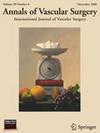股骨头内血管治疗外周动脉疾病后的双反射超声监测:系统综述和叙述性综述。
IF 1.4
4区 医学
Q3 PERIPHERAL VASCULAR DISEASE
引用次数: 0
摘要
目的综述现有文献,并就股骨铂道血管内治疗后的双工超声(DUS)监测提出一致建议:本系统性综述检索了有关股骨腘道血管内治疗后 DUS 监测和事件发生率的文献。主要终点是主要辅助通畅率。在双臂研究中,次要终点为主要通畅率、次要通畅率和肢体挽救率;在单臂研究中,DUS与其他监测方法相比的敏感性和特异性。对 PubMed、Embase 和 Cochrane 图书馆进行了检索。根据 "系统综述和元分析首选报告项目 "声明进行了系统综述。如果文章比较了 DUS 监测和其他监测方法,则符合条件。还包括报告血管内治疗后长期事件的前瞻性大型队列研究:最初的搜索结果是五项研究。只有一项双臂非随机研究比较了股腘支架置入术后DUS监测与踝肱指数(ABI)随访。DUS 组的主要辅助通畅率(12 个月时为 84% 对 76%,36 个月时为 68% 对 38%,P=.008)和肢体挽救率(12 个月时为 97% 对 83%,36 个月时为 90% 对 50%,P=.008)均有所提高:现有的稀缺证据表明,股骨腘绳肌束血管内治疗后进行 DUS 监测具有临床益处。本文章由计算机程序翻译,如有差异,请以英文原文为准。
Duplex Ultrasound Surveillance After Femoropopliteal Endovascular Treatment for Peripheral Arterial Disease: A Systematic Review and Narrative Synthesis
Background
To review the current literature and establish a consensual recommendation on duplex ultrasound (DUS) surveillance after endovascular treatment of the femoropopliteal tract.
Methods
This systematic review conducted literature searches on DUS surveillance after endovascular treatment of the femoropopliteal tract, and event rates. The primary end point was primary assisted patency. Secondary end points were primary patency, secondary patency, and limb salvage for double-armed studies, and sensitivity and specificity of DUS compared with other surveillance methods for single-armed studies. PubMed, Embase, and the Cochrane Library were searched. A systematic review was conducted according to the Preferred Reporting Items for Systematic reviews and Meta-Analyses statement. Articles were eligible if they compared DUS surveillance others surveillance methods. Prospective, large cohort studies reporting on long-term events after endovascular treatment were also included.
Results
The initial search resulted in 5 studies. Only one double-armed nonrandomized study compared DUS surveillance with ankle-brachial index (ABI) follow-up after femoropopliteal stenting. The DUS group demonstrated improved primary assisted patency (84% vs. 76% at 12 months and 68% vs. 38% at 36 months, P = 0.008) and limb salvage (97% vs. 83% at 12 months and 90% vs. 50% at 36 months, P < 0.001) compared with ABI follow-up. In one single-armed study, DUS surveillance showed a high sensitivity (91%) and specificity (100%) in detecting restenosis. ABI and clinical follow-up demonstrated a low sensitivity (55–67% and 52–64%, respectively) but reasonable specificity (80–85% and 82–88%, respectively) in detecting restenosis.
Conclusions
The scarce available evidence suggests a clinical benefit of DUS surveillance after endovascular treatment of the femoropopliteal tract.
求助全文
通过发布文献求助,成功后即可免费获取论文全文。
去求助
来源期刊
CiteScore
3.00
自引率
13.30%
发文量
603
审稿时长
50 days
期刊介绍:
Annals of Vascular Surgery, published eight times a year, invites original manuscripts reporting clinical and experimental work in vascular surgery for peer review. Articles may be submitted for the following sections of the journal:
Clinical Research (reports of clinical series, new drug or medical device trials)
Basic Science Research (new investigations, experimental work)
Case Reports (reports on a limited series of patients)
General Reviews (scholarly review of the existing literature on a relevant topic)
Developments in Endovascular and Endoscopic Surgery
Selected Techniques (technical maneuvers)
Historical Notes (interesting vignettes from the early days of vascular surgery)
Editorials/Correspondence

 求助内容:
求助内容: 应助结果提醒方式:
应助结果提醒方式:


